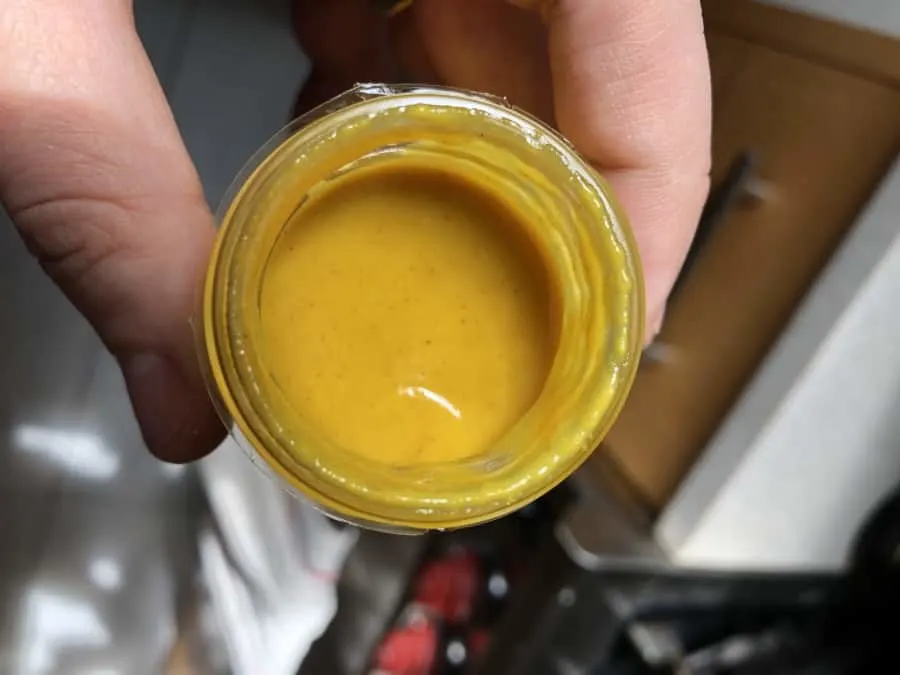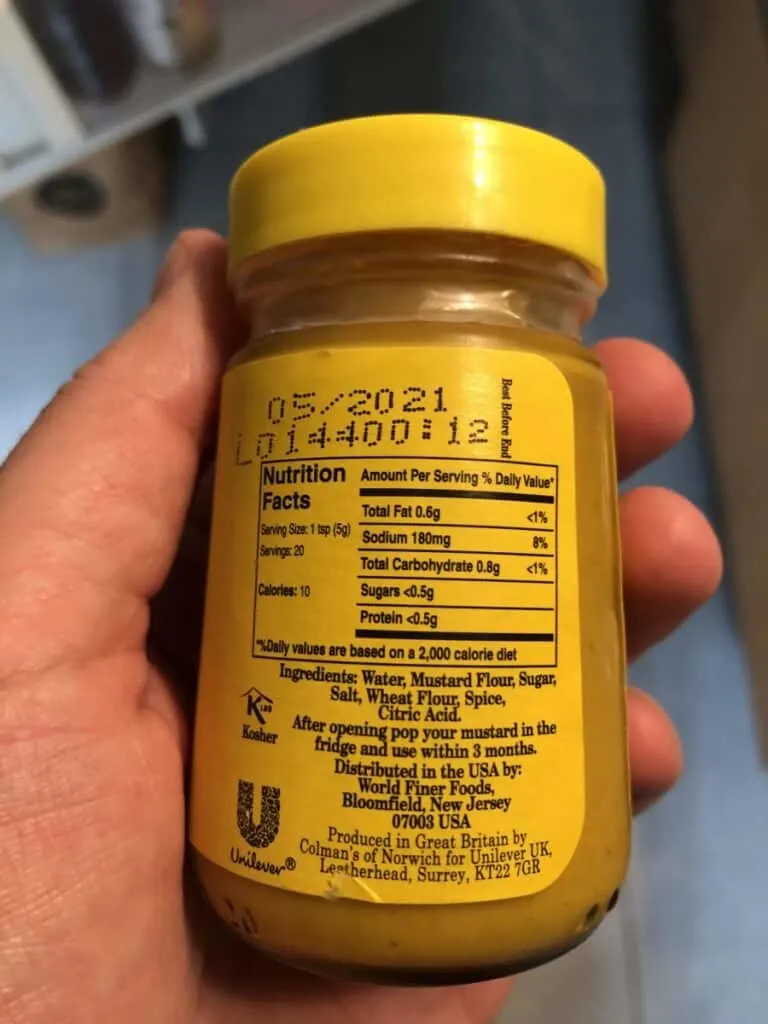Yellow mustard is one of the most popular and versatile condiments. It has got that unforgettable, sharp tang and aroma that adds a great layer of flavor to so many foods. The most common style of mustard in the U.S. is one we all recognize because of its vibrant yellow coloration. How does it get that yellow coloring?
Yellow mustard gets its color from two different sources. First, the mustard seeds used to make the condiment make a fine, yellow powder when ground. Secondly, turmeric is often used to further enhance the brilliant yellow hue of the product.
It really is as simple as that. Mustard seeds and turmeric spice are what give this popular condiment its famous color. But there is more to mustard than just its bright yellow appearance. In this article we will take a closer look at mustard and why it stands out so well in the world of condiments.

How do they make mustard yellow?
If you are wondering what color mustard is without additives, the answer is still yellow. The most basic recipe for mustard is simply ground up mustard seeds added to a liquid. Even this concoction will result in a yellow product, albeit less vibrant of a color than what we’re used to seeing.
This is technically all you need for the product to be considered mustard. Though this is technically a mustard, most of us want a little bit more consideration put into our mustard production. We want that bite and zesty spice on top of that hot dog or burger and ground mustard powder and water probably isn’t going to cut it.
The ground mustard seeds by themselves are not that pungent. That pungent flavor that we recognize as mustard needs a bit of coaxing to come out of the seeds. That is why the powder is then added to a liquid. This process brings about a chemical reaction in which enzymes in the ground up seed convert into mustard oil which is what creates that familiar pungent flavor and aroma.
The liquid that is used can further enhance or mellow out the mustard seeds’ spicy nature. Most commonly, vinegar and water are used. Vinegar tends to make sharper, but ultimately less spicy mustard as the vinegar slows the chemical reactions in the mustard seeds, creating a long-lasting, slow burn effect.
Using water, or other less acidic liquid, in a mustard heightens that pungent heat that can result in some very hot mustards. Though this makes a punchy sauce, low acid mustard doesn’t last as long as acidic mustard and loses its punch quickly.
What are the different types and colors of mustard?
There are several different types of mustard seed that are ground to be used in this condiment. All of them produce a yellowish powder. All mustards are yellow, or at least yellowish, from the start, though their color is often tweaked by what other ingredients that are added to the final recipe.
There are yellow, brown, and black mustard seeds that are all commonly used for different types of mustard. Though the outer flesh of the seeds themselves may be brown, or black, they still produce a yellow powder when they are crushed. So, nearly every mustard is at least on the yellow spectrum.
We have spicy brown mustard where the mustard powder is of a coarser grind and more of the seeds’ dark outer skin gives the condiment a darker color and a more pungent flavor, with more grit to its texture.
Then there are wine mustards, which are just as they sound, made with wine. The most famous of these is undoubtedly Dijon mustard, or French mustard, which is made with white wine. It has a pale-yellow coloration and a smooth complexity of flavor that is widely used as a cooking ingredient worldwide.
The color variations of mustard are basically endless. Because of the versatility of the base ingredients, you can add a lot of different things to the condiment and produce a spectrum of different flavors, spices, and colors. Honey mustards are going to be on the yellow-orange end of the spectrum, whereas a sriracha or BBQ mustard could be a vibrant red. Most of a mustard’s coloration comes from what you add to it beyond the mustard seed and liquid.
Is yellow mustard healthy?

All parts of the mustard plant have long been used as medicinal remedies in times past. Not only are the seeds rich in nutrients, but the leaves of the plant have beneficial vitamins and minerals as well.
Yellow mustard is one of the healthier condiment options available. It is low in calories though rich in iron, calcium, selenium, and phosphorus as well as antioxidants. In a world of condiments that are full of sugar and artificial additives, yellow mustard is not only one of the healthiest ways to add flavor to a meal, but also a great way to boost the nutritional value of your favorite foods.
Speaking of antioxidants, mustard is a great source of glucosinolates which are sulfur containing compounds that are commonly found in vegetables like broccoli and brussel sprouts. Some glucosinolates that mustard seeds are especially rich in are:
- Isothiocynates: This compound derived from the glucosinolates found in mustard seeds may help prevent cancer cells from growing. Additionally, it can hamper cancer cells’ ability to spread and replicate.
- Sinigrin: This gluconate derived compound is what gives mustard that pungent flavor and aroma and may help with inflammation. It may also have antibacterial, antifungal, anti-cancer, and healing properties.
And that is not all, mustard is full of other antioxidants like carotenoids, isorhamnetin, and kaempferol.
Mustard: what is hot and what is not
We have learned that mustard is yellow, fairly simple to make, and good for you. But, which type of mustard is the mildest and which type of mustard is the spiciest?
Mildest Mustard
Yellow Mustard: Yellow Mustard AKA “American Mustard” is one of the most popular and recognizable versions of the condiment for a reason. French’s Classic Yellow Mustard is the most popular, by far. It is mild, yet checks all the boxes for what we want in a mustard. The mild flavoring comes from the yellow mustard seed and blend of water and vinegar.
Spiciest Mustard
German Brown Mustard: Düsseldorfer Löwensenf Extra Scharf is a brown mustard from Germany that is widely accepted as one of the hottest, pure mustards. There are only four ingredients: mustard seed, vinegar, water and salt. This mustard is a great way to see the true heat potential of mustard seed.
Note: Though there are certainly hotter mustards out there, they are going to have other spicy ingredients added that increase spice levels of the condiment. Things like horseradish, wasabi, and sriracha are very popular additives to extra spicy mustards. We are listing this as the hottest, pure mustard out there.
Conclusion
Who would have thought that mustard could have so much complexity? It is simple to make and goes great with everything, yet has a wide range of variation. Some of the most popular kinds have only four ingredients yet possess layers of flavor and spice.
And let us not forget that yellow mustard is also good for you. Not only is it chock full of flavor, but the mustard seed itself is packed with beneficial vitamins, minerals, and antioxidants. You would be hard pressed to find a healthier alternative to add flavor and spice, as well as nutrients, to your meals.
